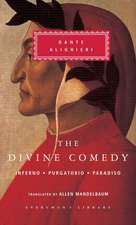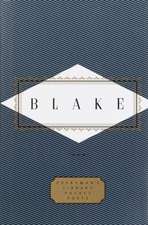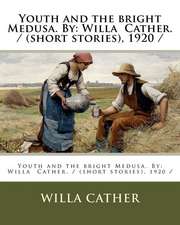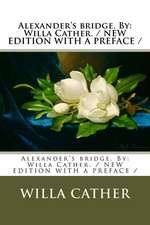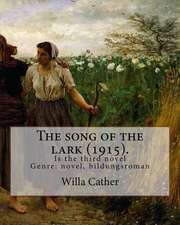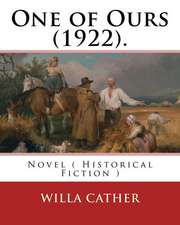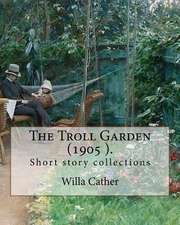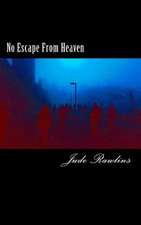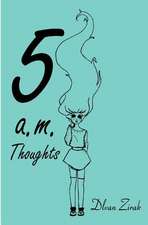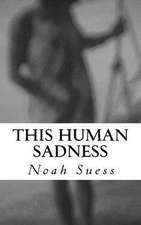April Twilights and Other Poems: Everyman's Library Pocket Poets
Autor Willa Cather Editat de Robert Thacker, Andrew Jewellen Limba Engleză Hardback – 25 mar 2013
In such lyrical poems as “The Hawthorn Tree,” “Winter at Delphi,” “Prairie Spring,” “Poor Marty,” and “Going Home,” Cather exhibits both a finely tuned sensitivity to the beauties of the physical world and a richly symbolic use of the landscapes of myth. The themes that were to animate her later masterpieces found their first expression in these haunting, elegiac ballads and sonnets.
Din seria Everyman's Library Pocket Poets
-
 Preț: 105.40 lei
Preț: 105.40 lei -
 Preț: 105.19 lei
Preț: 105.19 lei -
 Preț: 83.71 lei
Preț: 83.71 lei -
 Preț: 95.39 lei
Preț: 95.39 lei -
 Preț: 94.98 lei
Preț: 94.98 lei -
 Preț: 94.59 lei
Preț: 94.59 lei -
 Preț: 104.81 lei
Preț: 104.81 lei -
 Preț: 104.40 lei
Preț: 104.40 lei -
 Preț: 105.19 lei
Preț: 105.19 lei -
 Preț: 104.40 lei
Preț: 104.40 lei -
 Preț: 104.59 lei
Preț: 104.59 lei -
 Preț: 104.59 lei
Preț: 104.59 lei -
 Preț: 95.39 lei
Preț: 95.39 lei -
 Preț: 104.40 lei
Preț: 104.40 lei -
 Preț: 104.59 lei
Preț: 104.59 lei -
 Preț: 105.40 lei
Preț: 105.40 lei -
 Preț: 104.59 lei
Preț: 104.59 lei -
 Preț: 93.94 lei
Preț: 93.94 lei -
 Preț: 105.19 lei
Preț: 105.19 lei -
 Preț: 104.40 lei
Preț: 104.40 lei -
 Preț: 104.59 lei
Preț: 104.59 lei -
 Preț: 104.18 lei
Preț: 104.18 lei -
 Preț: 80.63 lei
Preț: 80.63 lei -
 Preț: 104.81 lei
Preț: 104.81 lei -
 Preț: 85.74 lei
Preț: 85.74 lei -
 Preț: 113.54 lei
Preț: 113.54 lei -
 Preț: 105.22 lei
Preț: 105.22 lei -
 Preț: 104.18 lei
Preț: 104.18 lei -
 Preț: 104.59 lei
Preț: 104.59 lei -
 Preț: 94.98 lei
Preț: 94.98 lei -
 Preț: 95.39 lei
Preț: 95.39 lei -
 Preț: 80.82 lei
Preț: 80.82 lei -
 Preț: 104.81 lei
Preț: 104.81 lei -
 Preț: 105.63 lei
Preț: 105.63 lei -
 Preț: 129.02 lei
Preț: 129.02 lei -
 Preț: 129.26 lei
Preț: 129.26 lei -
 Preț: 104.40 lei
Preț: 104.40 lei -
 Preț: 104.81 lei
Preț: 104.81 lei -
 Preț: 104.59 lei
Preț: 104.59 lei -
 Preț: 80.63 lei
Preț: 80.63 lei -
 Preț: 106.44 lei
Preț: 106.44 lei -
 Preț: 104.81 lei
Preț: 104.81 lei -
 Preț: 80.82 lei
Preț: 80.82 lei -
 Preț: 81.04 lei
Preț: 81.04 lei -
 Preț: 138.06 lei
Preț: 138.06 lei -
 Preț: 116.48 lei
Preț: 116.48 lei -
 Preț: 104.81 lei
Preț: 104.81 lei -
 Preț: 95.17 lei
Preț: 95.17 lei -
 Preț: 105.40 lei
Preț: 105.40 lei
Preț: 137.58 lei
Nou
Puncte Express: 206
Preț estimativ în valută:
26.34€ • 27.02$ • 22.18£
26.34€ • 27.02$ • 22.18£
Carte disponibilă
Livrare economică 01-07 februarie
Livrare express 22-28 ianuarie pentru 21.92 lei
Preluare comenzi: 021 569.72.76
Specificații
ISBN-13: 9780307961464
ISBN-10: 030796146X
Pagini: 232
Dimensiuni: 109 x 160 x 20 mm
Greutate: 0.22 kg
Editura: Everyman's Library
Seria Everyman's Library Pocket Poets
ISBN-10: 030796146X
Pagini: 232
Dimensiuni: 109 x 160 x 20 mm
Greutate: 0.22 kg
Editura: Everyman's Library
Seria Everyman's Library Pocket Poets
Extras
Excerpted from the Forward
When she was in her twenties, Willa Sibert Cather (1873ߝ1947) was by any estimate a one-woman literary industry: excerpts from her collected articles and reviews from this time, published mostly in newspapers in Lincoln, Nebraska and Pittsburgh, run to over one thousand pages in two volumes (The World and the Parish, 1970). During this period too she produced stories and poems, tried her hand at a book of drama criticism that never appeared, and was the first American editor ߝ when she was just twenty-three ߝ to republish poems from a new book by A. E. Housman, A Shropshire Lad (1896). When Cather did publish her first book in the spring of 1903, the year she turned thirty, it is not surprising that her April Twilights displays Housman’s evident influence, among others. That book, published in Boston by Richard G. Badger ߝ a vanity publisher who, notwithstanding, brought out volumes by various poets of note, such as E. A. Robinson ߝ garnered some reasonable reviews, won some admiration, but made no real splash.
April Twilights was the first book by this author whose career as a writer spanned the years from 1890s fin de sie`cle decadence through the Modernism of the 1920s and ’30s, and as a poet from the conventional prosody of the late Victorians through the free verse of the Imagists. Steeped in the literary, Cather initially took her inspiration from the classical tradition and from the poets of the nineteenth century, British, Continental, and American. In Housman’s A Shropshire Lad she found a new, authentic voice speaking with freshness and clarity through poems whose inspiration derived from a source she herself saw and felt ߝ a well-known home place recalled in precise detail and tinged with recollected longings. Its best-known poem is ‘‘To an Athlete Dying Young,’’ and that poem echoes throughout Cather’s work. Housman’s poems called out to Cather sufficiently to draw her to his Shropshire during her first visit to Europe in 1902. Having seen and delighted in his places, she wrote to Dorothy Canfield from there that ‘‘somehow it makes it all the greater to have it all true.’’ In that same letter she offers the three stanzas that were to conclude her ‘‘Poppies on Ludlow Castle.’’ On return from Shropshire, having discovered Housman’s address in London, Cather and her traveling companions visited the poet there unannounced. The meeting proved awkward, leaving Cather disappointed. There are a number of versions of what took place, and it was a moment in Cather’s biography that earned her some notoriety and also vexed her. Even when she died in 1947 she was seeking to set the record of that visit straight.
Whatever happened that day in Highgate, when April Twilights appeared the next year Housman’s influence was palpable: just after its publication Cather wrote to Viola Roseboro’ ߝ the fiction reader at McClure’s who would successfully facilitate Cather’s hiring by that magazine in 1906 ߝ that she had ‘‘been Housman’s bond slave, mentally, since his first volume appeared some six years ago.’’ Beyond Housman’s influence, Cather the young poet may be seen in April Twilights embracing her classical inheritance through several poems on classical themes (‘‘Fides, Spes,’’ ‘‘In Media Vita,’’ ‘‘Winter at Delphi’’), writing poems inspired by the scenes she saw in Britain (‘‘London Roses’’) and, especially, in France (‘‘Mills of Montmartre,’’ ‘‘Paris’’), and eulogizing an artist who died young, her Pittsburgh friend, the composer Ethelbert Nevin (‘‘Arcadian Winter,’’ ‘‘Sleep, Minstrel, Sleep’’). Tentatively, as well, Cather may be seen in her first book treating subjects which would prove ultimately to be central to her fiction: her family (‘‘Dedicatory,’’ ‘‘‘Grandmither, Think Not I Forget,’’’ ‘‘The Namesake’’) and her home place in the West (‘‘White Birch in Wyoming,’’ ‘‘The Night Express,’’ ‘‘Prairie Dawn’’). A review of April Twilights in the Kansas City Star described it as ‘‘a new little volume which holds pages of charming poetry,’’ while the New York Times reviewer wrote that Cather’s ‘‘gift is genuine, her performance already beautiful, and giving promise to be looked for with eagerness,’’ going on to note that her ‘‘slim first volume holds such a variety of metres, and so considerable a number of poems nearly equal in delicate whimsical charm, that the choice of any one for quotation is difficult.’’ Read today and with such responses in mind, April Twilights is a book that fits just who Willa Sibert Cather was in 1903: a person steeped in the literary, possessed of some small initial accomplishment in writing; a person intent on trying her hand at what was possible and what was then done; a person of considerable literary ambition.
For a decade after April Twilights appeared Cather continued to publish poems ߝ often in McClure’s where she was Managing Editor from 1908 to 1911 ߝ but with the publication of The Troll Garden (1905) her primary genre became prose fiction. Yet that book’s title and epigraphs acknowledged inspiration from Christina Rossetti’s ‘‘The Goblin Market’’ and also from a parable by Charles Kingsley connected to the fall of Rome. So Cather was still inspired, primarily, by the literary and by Old World cultural inheritances. The collection’s stories are largely concerned with art and artists, though there too Cather showed herself increasingly drawn to the West as her setting. This shift was paralleled in the poems she wrote during this time and, when she ultimately hit what she subsequently called ‘‘the home pasture’’ ߝ that is, her true subject and approach some of her own poetry was front and center. OPioneers! (1913), the book Cather saw as her true first novel, begins with one of her poems, ‘‘Prairie Spring,’’ as one of its epigraphs. Two years later, when Cather published her most autobiographical novel, The Song of the Lark, she used a poem of hers as part of that book’s dedication to Isabelle McClung, a love of Cather’s life:
On uplands,
At morning, The world was young, the winds were free;
A garden fair,
In that blue desert air, Its guest invited me to be.
With its image of western lands and its look back to a pastoral garden, this poem combines Cather’s poetic inheritance with the direction she was then taking, for just as she was looking toward the pioneering West in her prose so she was in her poetry too.
As this shift was happening, Cather responded in October 1915 to a question from her editor at Houghton Mifflin, Ferris Greenslet, who had asked if she might want to publish a revised volume of her poems. Cather replied that she would like ‘‘to bring out an expurgated and revised edition of April Twilights sometime.’’ While Houghton Mifflin never published such a book, after Cather changed her publisher with Youth and the Bright Medusa in 1920, Alfred A. Knopf did. April Twilights and Other Poems appeared from Knopf in spring 1923; its publication coincided with the Pulitzer Prize she won for One of Ours (1922). Thus as her career as a fiction writer was really taking off, Cather remained interested in her poetry and was actively reshaping it.
Just as Youth and the Bright Medusa had combined some of the stories from The Troll Garden with newer ones, April Twilights and Other Poems follows the same pattern. The revised collection is a very different book from its predecessor; it is in fact an ‘‘expurgated’’ rendering of Cather as poet in the sense that it represents her poems both stylistically and with greater emphasis on her own westward movement. One might quite reasonably see them as different books altogether. She omitted thirteen poems from the earlier volume and added another twelve ߝ as an identified and separate section ߝ made up of poems written since 1903, most published in McClure’s and other periodicals. With them, Cather did not altogether abandon European scenes as inspiration but, overall, she followed the direction announced with ‘‘Prairie Spring’’ as an epigraph to O Pioneers!: she had turned her face West, to the stuff of her own experience in her own home place, and, as also in that poem, she rendered her ideas through less conventional prosody. April Twilights and Other Poems ends with two poems that, themselves, end with the word ‘‘home’’: ‘‘Recognition’’ (1923) and ‘‘Going Home (Burlington Route)’’ (1923). In the latter Cather writes:
How smoothly the trains run beyond the Missouri; Even in my sleep I know when I have crossed the river. The wheels turn as if they were glad to go; They run like running water, Like Youth, running away . . .
Arguably, this same transformation occurred in Cather’s prose ߝ sharp, clear prose that has long been judged ‘‘poetic’’ ߝ as she moved from the conventional third-person structures of O Pioneers! and The Song of the Lark to the radical Modernist structures of My Ántonia (1918), The Professor’s House (1925), My Mortal Enemy (1926) and Death Comes for the Archbishop (1927). This image of home and of ‘‘Youth, running away . . .’’ connects to the lyric impulse and, as well and again, to looming death.
When April Twilights was reviewed in 1903 Cather was seen as a new, though conventional, voice ߝ a writer to watch, making a creditable appearance through a known but vanity press. When April Twilights and Other Poems appeared in early 1923 from a major though still relatively new publisher and was being reviewed that spring, Cather was established as a rapidly rising presence who was just about to win, or had just won, a big prize. Her next novel of the West, A Lost Lady, was then being serialized in Century and would appear as a book that fall. Given all this, her beginnings as a poet were, reasonably, little known. Such perspective was evident in the book’s notices. Mark Van Doren, in the Nation, wrote in June 1923 after the Pulitzer had been announced that in her novels ‘‘one comes home to an epic poet, to a great writer who deals simply and profoundly with love, age, separation, death, heroes, gods, and the land. No end of passion is there, and no end of reality. But her ‘Poems,’ so printed and so called, are not great.’’ Van Doren ends by asserting that ‘‘a poem like ‘Spanish Johnny’ reminds us of The Song of the Lark, and the reminder is fatal.’’ William Rose Benet, less categorical but equally unimpressed, wrote in The Literary Review that April Twilights and Other Poems ‘‘is but a slight pendant to her outstanding work in prose.’’ Another reviewer, writing in 1933 in the New York Herald-Tribune after Cather had added her major late poem, ‘‘Poor Marty’’ (1931), to the collection, explicitly defines the relation between Cather’s poems and her prose: ‘‘The setting is the prairies and their strange and sometimes harsh beauty. All in all, the later poems are far better, far more authentic than the earlier. Not Arcadian winter but Macon Prairie is Miss Cather’s correct setting.’’
When she was in her twenties, Willa Sibert Cather (1873ߝ1947) was by any estimate a one-woman literary industry: excerpts from her collected articles and reviews from this time, published mostly in newspapers in Lincoln, Nebraska and Pittsburgh, run to over one thousand pages in two volumes (The World and the Parish, 1970). During this period too she produced stories and poems, tried her hand at a book of drama criticism that never appeared, and was the first American editor ߝ when she was just twenty-three ߝ to republish poems from a new book by A. E. Housman, A Shropshire Lad (1896). When Cather did publish her first book in the spring of 1903, the year she turned thirty, it is not surprising that her April Twilights displays Housman’s evident influence, among others. That book, published in Boston by Richard G. Badger ߝ a vanity publisher who, notwithstanding, brought out volumes by various poets of note, such as E. A. Robinson ߝ garnered some reasonable reviews, won some admiration, but made no real splash.
April Twilights was the first book by this author whose career as a writer spanned the years from 1890s fin de sie`cle decadence through the Modernism of the 1920s and ’30s, and as a poet from the conventional prosody of the late Victorians through the free verse of the Imagists. Steeped in the literary, Cather initially took her inspiration from the classical tradition and from the poets of the nineteenth century, British, Continental, and American. In Housman’s A Shropshire Lad she found a new, authentic voice speaking with freshness and clarity through poems whose inspiration derived from a source she herself saw and felt ߝ a well-known home place recalled in precise detail and tinged with recollected longings. Its best-known poem is ‘‘To an Athlete Dying Young,’’ and that poem echoes throughout Cather’s work. Housman’s poems called out to Cather sufficiently to draw her to his Shropshire during her first visit to Europe in 1902. Having seen and delighted in his places, she wrote to Dorothy Canfield from there that ‘‘somehow it makes it all the greater to have it all true.’’ In that same letter she offers the three stanzas that were to conclude her ‘‘Poppies on Ludlow Castle.’’ On return from Shropshire, having discovered Housman’s address in London, Cather and her traveling companions visited the poet there unannounced. The meeting proved awkward, leaving Cather disappointed. There are a number of versions of what took place, and it was a moment in Cather’s biography that earned her some notoriety and also vexed her. Even when she died in 1947 she was seeking to set the record of that visit straight.
Whatever happened that day in Highgate, when April Twilights appeared the next year Housman’s influence was palpable: just after its publication Cather wrote to Viola Roseboro’ ߝ the fiction reader at McClure’s who would successfully facilitate Cather’s hiring by that magazine in 1906 ߝ that she had ‘‘been Housman’s bond slave, mentally, since his first volume appeared some six years ago.’’ Beyond Housman’s influence, Cather the young poet may be seen in April Twilights embracing her classical inheritance through several poems on classical themes (‘‘Fides, Spes,’’ ‘‘In Media Vita,’’ ‘‘Winter at Delphi’’), writing poems inspired by the scenes she saw in Britain (‘‘London Roses’’) and, especially, in France (‘‘Mills of Montmartre,’’ ‘‘Paris’’), and eulogizing an artist who died young, her Pittsburgh friend, the composer Ethelbert Nevin (‘‘Arcadian Winter,’’ ‘‘Sleep, Minstrel, Sleep’’). Tentatively, as well, Cather may be seen in her first book treating subjects which would prove ultimately to be central to her fiction: her family (‘‘Dedicatory,’’ ‘‘‘Grandmither, Think Not I Forget,’’’ ‘‘The Namesake’’) and her home place in the West (‘‘White Birch in Wyoming,’’ ‘‘The Night Express,’’ ‘‘Prairie Dawn’’). A review of April Twilights in the Kansas City Star described it as ‘‘a new little volume which holds pages of charming poetry,’’ while the New York Times reviewer wrote that Cather’s ‘‘gift is genuine, her performance already beautiful, and giving promise to be looked for with eagerness,’’ going on to note that her ‘‘slim first volume holds such a variety of metres, and so considerable a number of poems nearly equal in delicate whimsical charm, that the choice of any one for quotation is difficult.’’ Read today and with such responses in mind, April Twilights is a book that fits just who Willa Sibert Cather was in 1903: a person steeped in the literary, possessed of some small initial accomplishment in writing; a person intent on trying her hand at what was possible and what was then done; a person of considerable literary ambition.
For a decade after April Twilights appeared Cather continued to publish poems ߝ often in McClure’s where she was Managing Editor from 1908 to 1911 ߝ but with the publication of The Troll Garden (1905) her primary genre became prose fiction. Yet that book’s title and epigraphs acknowledged inspiration from Christina Rossetti’s ‘‘The Goblin Market’’ and also from a parable by Charles Kingsley connected to the fall of Rome. So Cather was still inspired, primarily, by the literary and by Old World cultural inheritances. The collection’s stories are largely concerned with art and artists, though there too Cather showed herself increasingly drawn to the West as her setting. This shift was paralleled in the poems she wrote during this time and, when she ultimately hit what she subsequently called ‘‘the home pasture’’ ߝ that is, her true subject and approach some of her own poetry was front and center. OPioneers! (1913), the book Cather saw as her true first novel, begins with one of her poems, ‘‘Prairie Spring,’’ as one of its epigraphs. Two years later, when Cather published her most autobiographical novel, The Song of the Lark, she used a poem of hers as part of that book’s dedication to Isabelle McClung, a love of Cather’s life:
On uplands,
At morning, The world was young, the winds were free;
A garden fair,
In that blue desert air, Its guest invited me to be.
With its image of western lands and its look back to a pastoral garden, this poem combines Cather’s poetic inheritance with the direction she was then taking, for just as she was looking toward the pioneering West in her prose so she was in her poetry too.
As this shift was happening, Cather responded in October 1915 to a question from her editor at Houghton Mifflin, Ferris Greenslet, who had asked if she might want to publish a revised volume of her poems. Cather replied that she would like ‘‘to bring out an expurgated and revised edition of April Twilights sometime.’’ While Houghton Mifflin never published such a book, after Cather changed her publisher with Youth and the Bright Medusa in 1920, Alfred A. Knopf did. April Twilights and Other Poems appeared from Knopf in spring 1923; its publication coincided with the Pulitzer Prize she won for One of Ours (1922). Thus as her career as a fiction writer was really taking off, Cather remained interested in her poetry and was actively reshaping it.
Just as Youth and the Bright Medusa had combined some of the stories from The Troll Garden with newer ones, April Twilights and Other Poems follows the same pattern. The revised collection is a very different book from its predecessor; it is in fact an ‘‘expurgated’’ rendering of Cather as poet in the sense that it represents her poems both stylistically and with greater emphasis on her own westward movement. One might quite reasonably see them as different books altogether. She omitted thirteen poems from the earlier volume and added another twelve ߝ as an identified and separate section ߝ made up of poems written since 1903, most published in McClure’s and other periodicals. With them, Cather did not altogether abandon European scenes as inspiration but, overall, she followed the direction announced with ‘‘Prairie Spring’’ as an epigraph to O Pioneers!: she had turned her face West, to the stuff of her own experience in her own home place, and, as also in that poem, she rendered her ideas through less conventional prosody. April Twilights and Other Poems ends with two poems that, themselves, end with the word ‘‘home’’: ‘‘Recognition’’ (1923) and ‘‘Going Home (Burlington Route)’’ (1923). In the latter Cather writes:
How smoothly the trains run beyond the Missouri; Even in my sleep I know when I have crossed the river. The wheels turn as if they were glad to go; They run like running water, Like Youth, running away . . .
Arguably, this same transformation occurred in Cather’s prose ߝ sharp, clear prose that has long been judged ‘‘poetic’’ ߝ as she moved from the conventional third-person structures of O Pioneers! and The Song of the Lark to the radical Modernist structures of My Ántonia (1918), The Professor’s House (1925), My Mortal Enemy (1926) and Death Comes for the Archbishop (1927). This image of home and of ‘‘Youth, running away . . .’’ connects to the lyric impulse and, as well and again, to looming death.
When April Twilights was reviewed in 1903 Cather was seen as a new, though conventional, voice ߝ a writer to watch, making a creditable appearance through a known but vanity press. When April Twilights and Other Poems appeared in early 1923 from a major though still relatively new publisher and was being reviewed that spring, Cather was established as a rapidly rising presence who was just about to win, or had just won, a big prize. Her next novel of the West, A Lost Lady, was then being serialized in Century and would appear as a book that fall. Given all this, her beginnings as a poet were, reasonably, little known. Such perspective was evident in the book’s notices. Mark Van Doren, in the Nation, wrote in June 1923 after the Pulitzer had been announced that in her novels ‘‘one comes home to an epic poet, to a great writer who deals simply and profoundly with love, age, separation, death, heroes, gods, and the land. No end of passion is there, and no end of reality. But her ‘Poems,’ so printed and so called, are not great.’’ Van Doren ends by asserting that ‘‘a poem like ‘Spanish Johnny’ reminds us of The Song of the Lark, and the reminder is fatal.’’ William Rose Benet, less categorical but equally unimpressed, wrote in The Literary Review that April Twilights and Other Poems ‘‘is but a slight pendant to her outstanding work in prose.’’ Another reviewer, writing in 1933 in the New York Herald-Tribune after Cather had added her major late poem, ‘‘Poor Marty’’ (1931), to the collection, explicitly defines the relation between Cather’s poems and her prose: ‘‘The setting is the prairies and their strange and sometimes harsh beauty. All in all, the later poems are far better, far more authentic than the earlier. Not Arcadian winter but Macon Prairie is Miss Cather’s correct setting.’’

